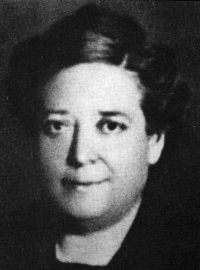Teresa Claramunt facts for kids
Quick facts for kids
Teresa Claramunt i Creus
|
|
|---|---|

Teresa Claramunt i Creus (1910)
|
|
| Born | 4 June 1862 |
| Died | 11 April 1931 (aged 68) |
| Resting place | Montjuïc Cemetery |
| Nationality | Catalan |
| Organization |
|
| Movement |
|
Teresa Claramunt i Creus (1862–1931) was an important woman from Catalonia, Spain. She was a Catalan activist who fought for workers' rights and women's rights. She lived during a time when many people were working to improve conditions for factory workers.
Teresa was a pioneer in fighting for women's rights within the workers' movement. She was one of the first to suggest that women who believed in freedom and equality should form their own groups. Years after her death, an organization called Mujeres Libres continued her work.
Contents
Early Life and Activism
Teresa Claramunt was born in 1862 in Sabadell, a city in Spain. Her family was part of the working class. Teresa worked in a textile factory, making clothes and fabrics.
She started an activist group in Sabadell. She was inspired by Fernando Tarrida del Mármol. Together, they took part in a seven-week strike in 1883. During this strike, they demanded that workers should only have to work 10 hours a day.
In 1884, Teresa helped create a group for workers in Sabadell. She believed that workers needed to be organized and educated. This was important for them to gain their freedom and fair treatment.
Fighting for Women's Rights
In 1892, Teresa Claramunt helped start the first women's rights group in Spain. It was called the Autonomous Society of Women of Barcelona. She founded it with Ángeles López de Ayala and Amalia Domingo Soler. This group focused on ideas of freedom and equality for all.
The group's first location was in Barcelona, on Carrer de la Cadena. Later, it moved to Carrer de Fernandina. Teresa lived very close to the group's headquarters.
In 1893, Teresa went to a meeting for students with her husband. However, she was stopped from entering the theater. The governor had banned women from attending. Teresa felt very unfairly treated because of this. She protested loudly.
Newspapers reported that many people attended the event. Afterward, there were clashes between the attendees and the Civil Guard. Because of this, Teresa and her husband were arrested. They were held in Montjuïc Castle and later faced a trial.
Facing Challenges and Exile
In 1896, there was a bombing in Barcelona. Teresa was arrested again and treated very harshly. This event had lasting effects on her health for the rest of her life.
Even though she was not found guilty of any crime, she was sent away from Spain. She lived in the United Kingdom until 1898.
After she returned to Spain in 1901, she started a magazine called El Productor. She was very active in social movements in the early 1900s. In 1902, she supported metal workers who were on strike. She also took part in a big general strike in February 1902.
Teresa wrote for several newspapers and magazines. She also managed a newspaper called El Rebelde from 1907 to 1908.
Later Years and Legacy
Teresa was arrested again in 1909 after a period of unrest known as the Tragic Week. She was imprisoned in Zaragoza. In 1911, she helped local worker groups join the National Confederation of Labor (CNT).
She also participated in another general strike in 1911. This led to her being imprisoned again. By this time, she was very ill and could barely move. In 1923, police searched her home in Zaragoza. They were looking for evidence related to an attack on a religious leader.
In 1924, Teresa moved back to Barcelona. However, her illness made it impossible for her to continue her public work. She spent her last years at her sister's house. The famous activist Emma Goldman even visited her there.
Teresa Claramunt passed away on April 11, 1931. She was buried in the Montjuïc Cemetery on the same day that the Second Spanish Republic was declared.
Teresa Claramunt is remembered for her dedication to workers' rights and women's rights. In her hometown of Sabadell, a street and a school are named after her.
See also
 In Spanish: Teresa Claramunt para niños
In Spanish: Teresa Claramunt para niños

